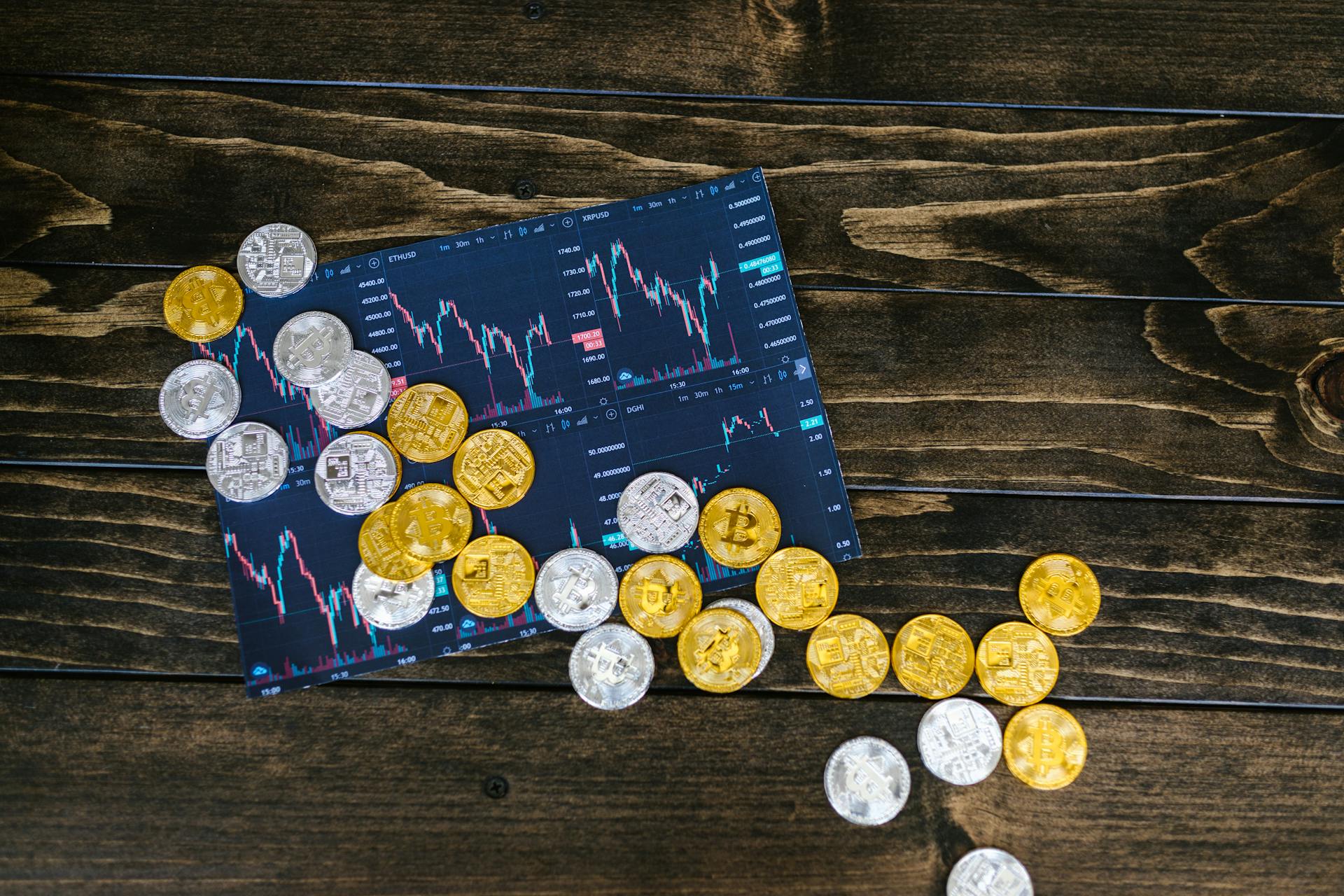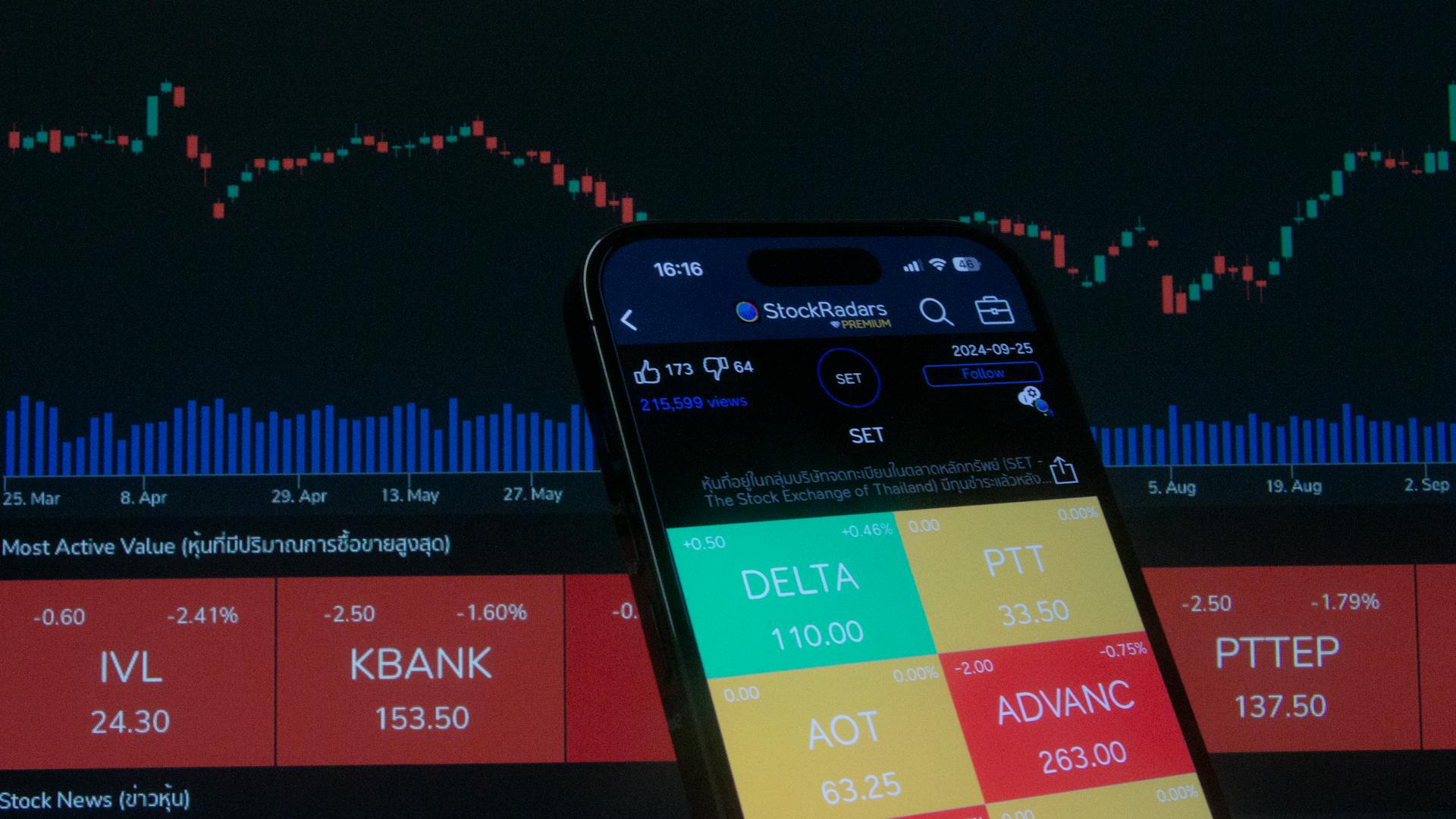
Calculating and understanding the equity market risk premium is crucial for investors and financial analysts. This premium is the additional return an investor expects to earn on stocks compared to risk-free assets like bonds.
The equity market risk premium is often estimated using historical data, with a common approach being to calculate the average excess return of the stock market over a risk-free rate, such as the 10-year Treasury bond yield.
A key factor in determining the equity market risk premium is the investor's risk tolerance and investment horizon. For example, a long-term investor may be willing to take on more risk in pursuit of higher returns.
Studies have shown that the equity market risk premium can vary significantly over time, with some periods experiencing much higher premiums than others.
A different take: The Dhandho Investor the Low-risk Value Method to High Returns
What Is Equity Market Risk Premium?
The equity market risk premium is the difference between returns on stocks and the risk-free rate of return. It's the excess return a stock pays to the holder over and above the risk-free rate for the risk the holder is taking.
It's a crucial concept in investing, as it represents the compensation investors require for taking on the risk of investing in stocks rather than opting for the safety of risk-free assets like government bonds. The risk-free rate is typically the yield on government bonds, such as U.S. Treasury bonds.
The equity risk premium and the level of risk are directly correlated. The higher the risk, the higher is the gap between stock returns and the risk-free rate and hence, a higher premium.
For example, if government bonds are giving an investor 6% returns, any rational investor would choose the stock of any company only if it gave more than 6% returns, say 14%. Here, 14% – 6% = 8% is the equity risk premium.
Investors demand a premium for taking on the risk of investing in stocks, and this premium is captured by the market risk premium, which is used to determine the expected return of an asset based on its systematic risk.
Related reading: Green Bonds Meaning
Importance and Types
The equity market risk premium is a crucial concept in the world of finance, and understanding its importance can make a significant difference in your investment decisions. It helps investors estimate potential returns from risky assets like stocks, making informed decisions about whether to invest in the stock market or allocate resources elsewhere.
Investors use the market risk premium to determine the required rate of return on various assets, enabling them to build diversified portfolios that align with their risk tolerance and return expectations. This is a key aspect of portfolio management.
The market risk premium is a critical component in many financial models, including CAPM. By calculating the expected returns based on the market risk premium, analysts can assess whether stocks are overvalued, undervalued, or fairly priced.
Knowing the market risk premium allows investors to better understand the trade-off between risk and reward. If the market risk premium is high, it indicates a riskier market environment where investors demand more compensation for taking on risk.
Here's an interesting read: Equity Risk Premium vs Market Risk Premium
Here are the four main reasons why understanding the market risk premium is essential:
- Investment Decision-Making: Investors use the market risk premium to estimate potential returns from risky assets like stocks.
- Portfolio Management: Portfolio managers use the market risk premium to determine the required rate of return on various assets.
- Valuation Models: The market risk premium is a critical component in many financial models, including CAPM.
- Risk Assessment: Knowing the market risk premium allows investors to better understand the trade-off between risk and reward.
Common Misconceptions
History tells us what past returns have been, not what we can expect in the future. Backward-looking excess returns are wildly variable, ranging from +18.9% to –13.4% per year over the past 222 years.
Few people would consider a 19% annual risk premium reasonable, and no one would consider a –13% risk premium reasonable. Extrapolating past excess returns to forecast the future equity risk premium is a common but flawed approach.
The average corporate pension fund used a 9.5% return assumption in 2000, implying a 12% return expectation for stocks at a time when bond yields were 6%. This led to unrealistic expectations of double-digit growth in earnings, dividends, and share prices.
Myth: History as Predictor
History is not a reliable predictor of future returns, as we can see from the rolling 10-year stock and bond market returns over the past 222 years, which vary wildly.
Related reading: Standard Deviation Investment Returns

The difference between these returns, known as the excess return, ranges from +18.9% to –13.4% per year, making it difficult to set reasonable return expectations.
A 19% annual risk premium seems unreasonable, and a –13% risk premium is clearly not feasible, yet many investors rely on past excess returns to forecast future returns.
This approach is flawed because it's based on backward-looking data, rather than forward-looking expectations.
The finance community has gotten it wrong by using past excess returns to set return expectations, as seen in the case of corporate pension funds during the dot-com bubble in 2000.
They used an all-time high 9.5% "pension return assumption" for conventional balanced portfolios, implying a 12% return expectation for stocks, which is unrealistic given the low dividend yield at the time.
In fact, the stock market offered an all-time low 1.1% dividend yield, making it necessary to expect double-digit growth in earnings, dividends, and share prices in the decades ahead to achieve a 12% expected return.
Recommended read: Combank Level 1
Myth: 5% of the Population

The "5% of the population" myth is a common misconception that's been debunked by research.
According to studies, only about 0.3% of the population is actually psychopathic.
This myth likely originated from a 1941 book that estimated 5% of the population was psychopathic, but this figure has been widely discredited.
Research suggests that the actual prevalence of psychopathy is much lower than previously thought, and is likely influenced by a combination of genetic and environmental factors.
Suggestion: Equity Market Research
Myth: Static Nature
The idea that the Equity Risk Premium (ERP) is static is a common misconception. This myth suggests that when dividend yields go down, it's because growth expectations are rising, leaving the ERP unaffected.
Nothing in neoclassical finance theory supports the idea that the ERP must be static. Behavioral finance proponents reject a static ERP, as risk expectations, investment horizons, and personal financial circumstances are all nonstationary.
Risk tolerance is not fixed, it changes over time and varies across individuals and society. This means that the ERP is not a constant value, but rather a dynamic concept that can shift based on various factors.
The ERP is influenced by a range of factors, including risk expectations, investment horizons, and personal financial circumstances.
You might enjoy: Financial System
Calculating the Risk Premium
Calculating the risk premium is a straightforward process that requires accurate data. The most common formula for calculating the market risk premium is Market Risk Premium = Expected Market Return - Risk-Free Rate.
To calculate the expected market return, you can use historical market performance or future projections. For example, the historical average annual return of the S&P 500 is 8%. The risk-free rate is typically the yield on long-term U.S. Treasury bonds, such as the current yield on a 10-year U.S. Treasury bond, which is 2%.
Using these two components, the market risk premium can be calculated. For instance, if the expected market return is 8% and the risk-free rate is 2%, the market risk premium would be 6%. This means that investors expect to earn a 6% premium for taking on the additional risk associated with investing in the stock market.
The equity risk premium is similar, but it's calculated using the rate of return on the stock market and the risk-free rate. For example, if the rate of return on the S&P 500 is 8% and the risk-free rate is 4%, the equity risk premium would be 4%.
Here's a summary of the key components:
Calculating
Calculating the risk premium is a crucial step in understanding the potential returns of an investment. The most common formula for calculating the market risk premium is straightforward: Market Risk Premium = Expected Market Return - Risk-Free Rate.
To calculate the market risk premium, you need to know the expected market return and the risk-free rate. The expected market return is the return that investors expect to earn from the stock market, which can be based on historical market performance or future projections. For example, if the historical average annual return of the S&P 500 is 8%, this figure would represent the expected market return.
The risk-free rate is the return on government securities that are considered free from default risk. Typically, the yield on long-term U.S. Treasury bonds is used as the risk-free rate. For example, if the current yield on a 10-year U.S. Treasury bond is 2%, this figure would represent the risk-free rate.
A different take: Libor Rate Daily History
Here's an example of how to calculate the market risk premium using these two components: if the expected market return is 8% and the risk-free rate is 2%, the market risk premium would be 6%.
The market risk premium can also be calculated using the Equity Risk Premium formula: Equity Risk Premium (on the Market) = Rate of Return on the Stock Market - Risk-free Rate. For instance, if the rate of return on the market is 8% and the risk-free rate is 4%, the equity risk premium would be 4%.
In general, the risk-free rate can be taken as the current rate on long-term government securities, such as Treasury Inflation-Protected Securities (TIPS). The TIPS yield is already a real yield, making it a good proxy for the risk-free rate.
Here's a summary of the steps to calculate the equity risk premium:
The equity risk premium is the excess return that investors expect to earn from stocks relative to bonds or cash. It's a key concept in understanding the potential returns of an investment.
Assumptions
Assumptions are a crucial part of the equity risk premium model, and it's essential to understand where they come from and why they're made.
The model assumes that the entire stock market will outperform risk-free securities over the long term, which is a relatively safe assumption.
This assumption allows for varying returns of different sectors and short-term market fluctuations, as seen in calendar year 2021 when the S&P 500 jumped 26%.
However, this assumption may not hold true in the long run, as evidenced by the 17% increase in combined forward EPS and 60+% increase in trailing EPS, which are unsustainable phenomena.
The model also requires that real growth in dividends per share or EPS be limited to very low single-digit growth rates in the long run, which is a reasonably debated assumption.
Studies of historical returns, such as those by Robert Arnott, Peter Bernstein, or Jeremy Siegel, show that such growth rarely exceeds 2% for a sustained period.
See what others are reading: Agency Banking Model
Optimists argue that technology could lead to a discontinuous leap in productivity, but even if this happens, the benefits are likely to accrue to selected sectors rather than all stocks.
The model's dubious assumption is that current valuation levels are approximately correct, which is just a guess, especially considering the P/E multiple of 25 and the price-to-dividend yield of 65 at the end of 2022.
Frequently Asked Questions
What is the equity risk premium for 2024?
The U.S. Equity Risk Premium is 5.0% as of June 5, 2024. This rate reflects the recommended level by Kroll Lowers, effective from that date.
What is the equity risk premium now?
The current equity risk premium in the United States is 5.5 percent, reflecting a slight decrease in investor demand for returns on investments with associated risk. This premium has remained relatively stable between 5.3 and 5.7 percent since 2011.
Sources
- https://intrinio.com/blog/what-is-market-risk-premium-and-how-to-calculate-it
- https://www.researchaffiliates.com/publications/articles/1064-equity-risk-premium-myths
- https://corporatefinanceinstitute.com/resources/valuation/market-risk-premium/
- https://corporatefinanceinstitute.com/resources/valuation/equity-risk-premium/
- https://www.investopedia.com/investing/calculating-equity-risk-premium/
Featured Images: pexels.com


